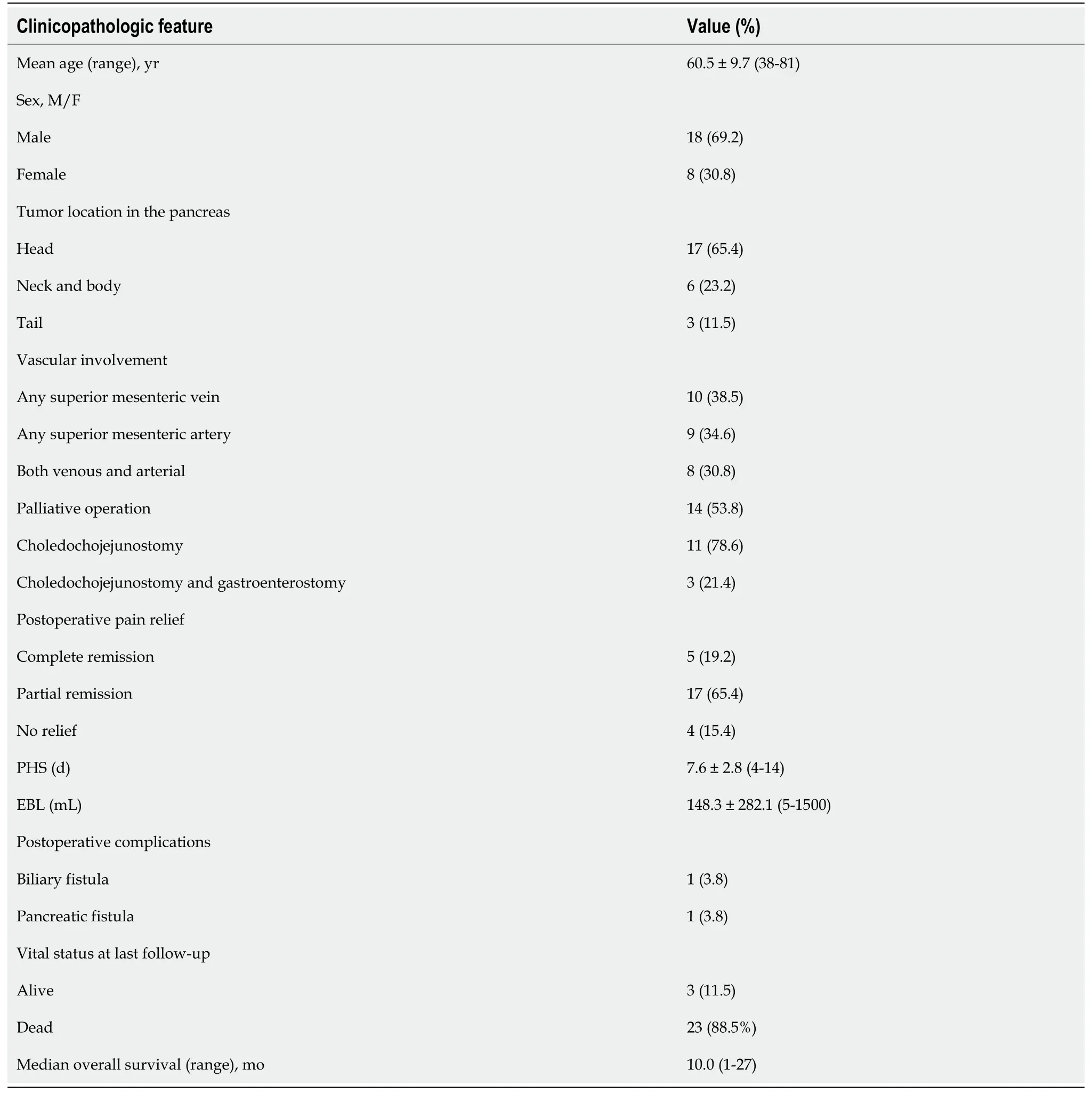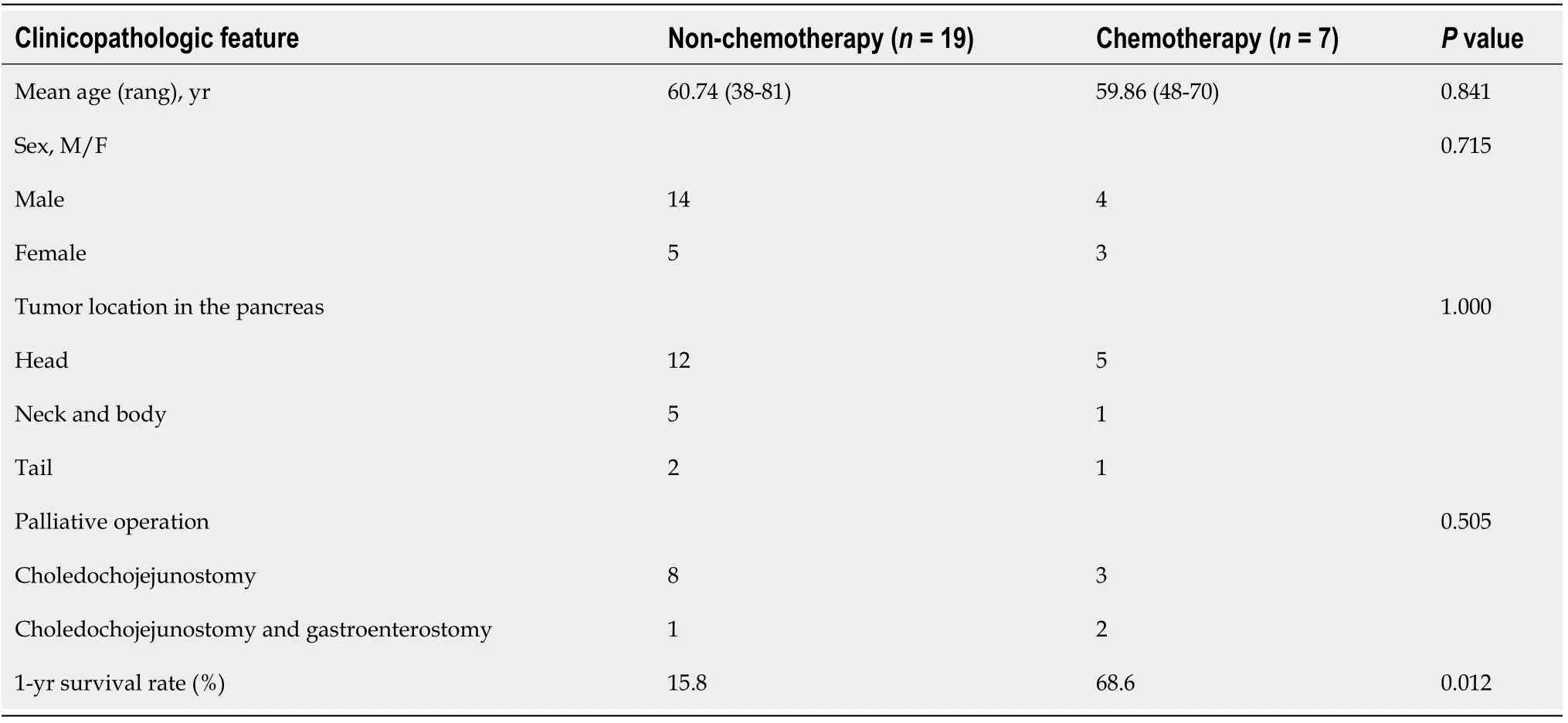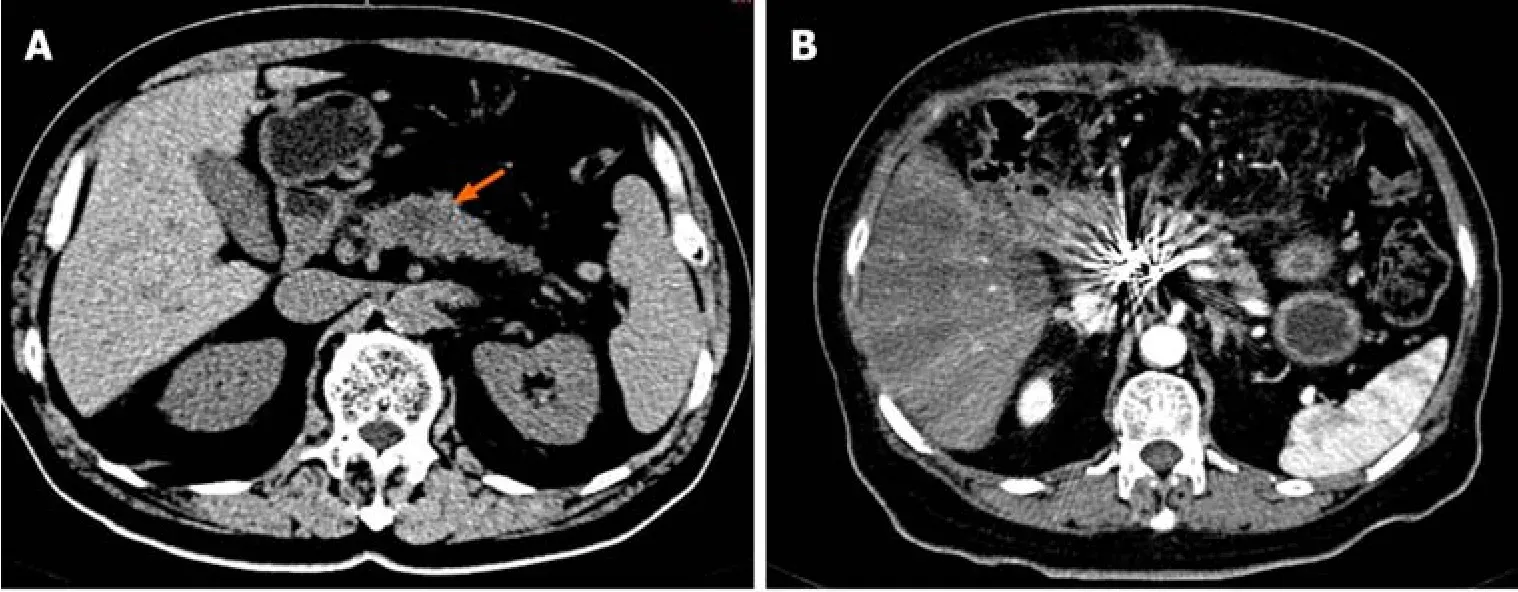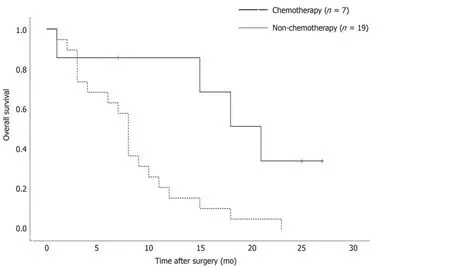Radioactive 125I seed implantation for pancreatic cancer with unexpected liver metastasis:A preliminary experience with 26 patients
Cheng-Gang Li,Zhi-Peng Zhou,Yu-Ze Jia,Xiang-Long Tan,Yu-Yao Song,Second Department of Hepatobiliary Surgery,Chinese PLA General Hospital,Beijing 100853,China
Abstract BACKGROUND Preoperative diagnosis rate of pancreatic cancer has increased year by year.The prognosis of pancreatic cancer patients with unexpected liver metastasis found by intraoperative exploration is very poor,and there is no effective and unified treatment strategy.AIM To evaluate the therapeutic effect of radioactive 125I seed implantation for pancreatic cancer patients with unexpected liver metastasis.METHODS The demographics and perioperative outcomes of patients who underwent 125I seed implantation to treat pancreatic cancer with unexpected liver metastasis between January 1,2017 and June 1,2019 were retrospectively analyzed.During the operation,125I seeds were implanted into the pancreatic tumor under the guidance of intraoperative ultrasound,with a spacing of 1.5 cm and a row spacing of 1.5 cm.For patients with obstructive jaundice and digestive tract obstruction,choledochojejunostomy and gastroenterostomy were performed simultaneously.After operation,the patients were divided into a non-chemotherapy group and a chemotherapy group that received gemcitabine combined with albumin-bound paclitaxel treatment.RESULTS Preoperative imaging evaluation of all patients in this study showed that the tumor was resectable without liver metastasis.There were 26 patients in this study,including 18 males and 8 females,aged 60.5 ± 9.7 years.The most common tumor site was the pancreatic head (17,65.4%),followed by the pancreatic neck and body (6,23.2%) and pancreatic tail (3,11.4%).Fourteen patients (53.8%)underwent palliative surgery and postoperative pain relief occurred in 22 patients(84.6%).The estimated blood loss in operation was 148.3 ± 282.1 mL and one patient received blood transfusion.The postoperative hospital stay was 7.6 ± 2.8 d.One patient had biliary fistula,one had pancreatic fistula,and all recovered after conservative treatment.After operation,7 patients received chemotherapy and 19 did not.The 1-year survival rate was significantly higher in patients who received chemotherapy than in those who did not (68.6% vs 15.8%,P = 0.012).The mean overall survival of patients in the chemotherapy group and non-chemotherapy group was 16.3 mo and 10 mo,respectively (χ2 = 7.083,P = 0.008).CONCLUSION Radioactive 125I seed implantation combined with postoperative chemotherapy can prolong the survival time and relieve pain of pancreatic cancer patients with unexpected liver metastasis.
Key Words:Pancreatic cancer;Liver metastases;Radioactive 125I seeds;Radiotherapy;Permanent implantation;Therapeutic effect
INTRODUCTION
In recent years,with the development of computer technology and imaging technology combined with the detection of serum tumor markers,the preoperative diagnosis rate of pancreatic cancer has increased year by year.Pancreatic cancer is characterized by insidious onset,rapid progress,and poor prognosis[1,2].It is a common tumor in the digestive system,and patients usually lack of early symptoms.Most of patients are at the late stage of disease when diagnosed,and radical resection is the most effective treatment for pancreatic cancer[3].Clinically,only 20% of patients have surgical conditions,while the rest can only receive palliative treatment[4-6].
Even if enhanced computed tomography (CT),magnetic resonance imaging (MRI),or positron emission tomography/computed tomography (PET/CT) was performed before the operation,about 8% of the patients who planned to undergo radical resection still had liver metastasis found during the exploration.Liver metastasis is a sign of advanced stage of pancreatic cancer.Usually,surgeons only terminate the operation for such patients after pathology.If there is obstructive jaundice or digestive tract obstruction,palliative operations such as choledochojejunostomy and gastrointestinal anastomosis can be performed.
The liver is the most common organ with metastasis of pancreatic cancer.The average survival time of pancreatic cancer patients with liver metastasis is only 3-6 mo[7].There is no consensus on the treatment strategy for patients with pancreatic cancer and liver metastasis.There are simultaneous pancreatectomy combined with liver metastasis resection,first pancreatectomy followed by liver metastasis resection,resection of pancreatic cancer combined with radiofrequency ablation of liver metastasis,systemic chemotherapy combined with TACE treatment of liver metastasis,immunotherapy,and so on.None of the above treatments is satisfactory.
Since 1965,radioactive125I seeds began to be used in cancer treatment.It was initially used in the treatment of prostate cancer and achieved success[8].A number of studies have shown that implantation of radioactive seeds in the treatment of pancreatic cancer can benefit the survival of patients,reduce pain,and improve the quality of their life[9-11].The purpose of this study was to summarize a single center experience with125I seed implantation combined with postoperative chemotherapy in the treatment of pancreatic cancer patients with unexpected liver metastasis.
MATERIALS AND METHODS
Patients
The clinical data of 26 patients with pancreatic cancer with unexpected liver metastasis who underwent125I seed implantation between January 1,2017 and June 1,2019 were retrospectively analyzed.This study was approved by the Institutional Review Board of Chinese PLA General Hospital.
Selection of the patients
The inclusion criteria were:(1) Preoperative CT,MRI,or PET-CT and other imaging examination showed no liver metastasis;(2) Primary pancreatic cancer with unexpected liver metastasis,with no other organ metastasis detected;and (3) In order to relieve jaundice and obstruction of digestive tract,anastomosis was performed and125I seeds were implanted in the tumor.The exclusion criteria were:(1) KPS score <70;(2) Preoperative imaging findings of liver or other organs metastasis;and (3) Other medical conditions that contraindicated anesthesia and surgery.
Physical characteristics of 125I seeds
The physical half-life of the125I seeds (China Isotope &Radiation Corporation,Beijing,China) used in this study is 59.6 d,the diameter is 0.8 mm,the length is 4.5 mm,and the wall thickness is 0.05 mm.The half value layer of the seeds for lead is 0.025 mm and it is 20.0 mm for soft tissue in human body.The activity range of a single seed is 11.1-37 MBq and it can radiate 27.4 and 31.4 kev X-ray and 35.5 kev γ-ray.
Preoperative evaluation
MRI,contrast-enhanced CT,or PET-CT was performed as a routine diagnostic procedure.During the operation,125I seeds were implanted into the tumor under the guidance of intraoperative ultrasound,with a spacing of 1.5 cm and a row spacing of 1.5 cm.The matched peripheral dose of125I seeds implanted in patients in this study was 110-160 Gy.
Perioperative data
The baseline demographics and perioperative and pathology data were obtained from the electronic medical records.The clinical outcomes,including estimated blood loss(EBL),postoperative complications,postoperative hospital stay (PHS),and overall survival time (OS),were analyzed retrospectively.Postoperative biliary fistula was defined as the outflow of bile or bile containing fluid from the abdominal drainage tube.Postoperative pancreatic fistula was defined as pancreatic juice flowing out of the body through abdominal drainage tube or incision,and the amylase content in the drainage fluid was three times higher than that in the blood.
Surgical technique and postoperative chemotherapy
During the operation,tumor metastasis and resectability of the primary tumor in the pancreas were investigated.If there was metastasis in the liver and no metastasis in other organs of the abdominal cavity,part of the liver metastases was resected and frozen pathological examination was performed.According to the location of pancreatic tumor,the Kocher incision and gastrocolic ligament were dissociated to expose the pancreatic tumor.After confirmed by pathology as pancreatic cancer,125I seeds were implanted into the tumor under the guidance of intraoperative ultrasound.For patients with obstructive jaundice and digestive tract obstruction,choledochojejunostomy and gastroenterostomy were performed simultaneously.After operation,the patients were divided into a non-chemotherapy group and a chemotherapy group that received gemcitabine combined with albumin-bound paclitaxel treatment.
All patients were followed 1 mo after discharge and then at 3-mo intervals thereafter.
Statistical analysis
Continuous data are presented as the mean ± SD or median and interquartile range according to their distributions.The Student’st-test was used to compare normally distributed variables between groups,whereas the Mann-WhitneyUtest was used for non-normally distributed variables.Categorical data were compared using the Chisquared test.OS was estimated using the Kaplan-Meier method,and comparison of OS between subgroups was performed using the log-rank test.Univariate and multivariate analyses were performed using the Cox proportional hazards regression model for potential prognostic factors on OS.APvalue of <0.05 was considered statistically significant.All analyses were performed with IBM SPSS statistical software,version 20 (SPSS,Chicago,IL,United States).
RESULTS
Patient characteristics
There were 26 patients in this study,including 18 males and 8 females,aged 60.5 ± 9.7 years.Table 1 shows the detailed characteristics of those patients.Most of the tumors occurred in the head of the pancreas (17,65.4%),in the pancreatic neck and body (6,23.2%),or in the pancreatic tail (3,11.4%).Palliative surgery was performed in 14 patients (53.8%) and postoperative pain was relieved in 22 patients (84.6%).All patients were confirmed as having pancreatic adenocarcinoma by postoperative pathology.
Perioperative outcomes
Preoperative imaging evaluation of all these patients showed that the tumor was resectable without liver metastasis.125I seeds were successfully implanted in all the patients,of whom 11 underwent choledochojejunostomy,and 3 underwent choledochojejunostomy combined with gastroenterostomy.The EBL in operation was 148.3 ± 282.1 (5-1500) mL and one patient needed blood transfusion.Bile fistula and pancreatic fistula occurred in one patient each,and all the patients recovered after conservative treatment.The PHS of all patients was 7.6 ± 2.8 d.Postoperative reexamination of CT showed that the125I seeds were evenly distributed in tumor(Figure 1).
Postoperative survival analysis
Three patients were still alive and 23 died at the last follow-up.Among all patients,19 did not receive chemotherapy,and 7 received chemotherapy.Table 2 shows the comparison between the two groups of patients.No significant difference was detected in gender,age,operation mode,or tumor location between the two groups.There was a significant difference in 1-year survival rate of patients who received chemotherapy and those who did not (68.6%vs15.8%,P= 0.012).Figure 2 shows the significant difference in mean OS of patients who received chemotherapy and those who did not (16.3 movs10 mo,χ2= 7.083,P= 0.008).
DISCUSSION
Pancreatic cancer often develops metastasis early because of the rapid growth of tumor cells,the rich blood vessels and lymphatic vessels around the pancreas,and the lack of a complete capsule.The liver is the most common target organ for metastasis of pancreatic cancer.The metastasis pathway of cancer locating in the pancreatic head is different from that of the pancreatic body and tail[12,13].Cancer of the pancreas head often invades the common bile duct,duodenum,stomach,and celiac arteries,and its lymph node metastasis pathway is from the lymph nodes around the superior mesenteric artery and the lymph nodes around the aorta.However,cancer of the pancreas body and tail metastasizes to the lymph nodes of the upper pancreas and the hilum of the liver,and finally to the liver.
Liver metastasis of pancreatic cancer often has multiple focuses,which can occur in both left and right lobes of the liver.Patients often lose the chance of radical operation.For pancreatic cancer patients with liver metastasis,the treatment is limited and the total effect is not ideal.However,if the condition allows,active treatment such as surgery and interventional chemotherapy can still improve the quality of life and prolong the survival period of such patients.The biological behavior of pancreaticcancer itself is not sensitive to radiotherapy,and the radiation tolerance of its surrounding tissues is low.Therefore,it is difficult for conventional external radiotherapy to accurately locate the lesion area,so as to make enough therapeutic dose of radiation reach the target area,or even reach the tumor target area;it also causes great damage to the surrounding organs[14-16].

Table 1 Characteristics of pancreatic cancer patients with unexpected liver metastasis (n = 26)
125I seeds can continuously release a low dose of γ-ray when they are implanted into tumor tissue.It can damage the DNA of tumor cells and induce apoptosis of tumor cells,so as to kill the proliferative cancer cells[17,18].The advantages of125I seeds in the treatment of pancreatic cancer are local adaptation and low dose continuous therapy[19-21].Compared with radical resection,local implantation of125I seeds in pancreatic cancer has less trauma,faster postoperative recovery,less impact on patients’ immunity,shorter postoperative recovery period,and less impact on early postoperative chemotherapy.
Our results showed that patients with pancreatic cancer with unexpected liver metastasis experienced pain relief and quality of life was improved after implantation of radioactive125I seeds.The combination of postoperative chemotherapy is helpful toprolong the survival period of such patients.We suggest that all patients take biopsy of tumor tissue during operation,and if possible,we suggest that gene detection of biopsy samples of those patients be performed so as to choose a possible and effective scheme for further chemotherapy after operation.

Table 2 Baseline data of patients from the two groups (n = 26)

Figure 1 Radioactive 125I seeds implanted in pancreatic cancer patients with unexpected liver metastasis.
In order to reduce the occurrence of pancreatic fistula and bleeding during and after radioactive seed implantation,our experience is that the puncture point is carefully sutured with 4/0 prolene suture after the puncture needle has been removed from each implantation site.During the operation,the needle channel should be carefully adjusted under the guidance of ultrasound to avoid the puncture into the blood vessel and the dilated pancreatic duct[22,23].The postoperative complications such as seed displacement,local embolism,pain,liver dysfunction,and pancreatic fistula were all recovered after conservative treatment in this study.The main shortcoming of this study is that the case was selected from a single center.In the next step,we will combine more centers to do this study.
CONCLUSION
In conclusion,our experience showed that the survival time could be prolonged and the quality of life be improved in pancreatic cancer patients with unexpected liver metastasis by125I seed implantation combined with postoperative chemotherapy.More cases need to be accumulated in future studies to determine the effectiveness of this treatment strategy further.

Figure 2 Kaplan-Meier cumulative survival curves according to chemotherapy status.
ARTICLE HIGHLIGHTS
Research background
The liver is the most common target organ for metastasis of pancreatic cancer.The survival time of pancreatic cancer patients with liver metastasis is very short,and they need timely and effective treatment.
Research motivation
There is no consensus on the treatment strategy for patients with pancreatic cancer and liver metastasis.
Research objectives
To evaluate the therapeutic effect of radioactive125I seed implantation for pancreatic cancer patients with unexpected liver metastasis.
Research methods
The demographics and perioperative outcomes of patients who underwent125I seed implantation to treat pancreatic cancer with unexpected liver metastasis were retrospectively analyzed.
Research results
There was a significant difference in the 1-year survival rate between the chemotherapy group and non-chemotherapy group.The mean overall survival of patients in the chemotherapy group was 16.3 mo,while it was 10 mo in the nonchemotherapy group.
Research conclusions
The survival time of pancreatic cancer patients with unexpected liver metastasis could be prolonged,and their quality of life could be improved by125I seed implantation combined with postoperative chemotherapy.
Research perspectives
With the development of science and technology,the cure rate of cancer will be higher and higher.
 World Journal of Clinical Cases2021年4期
World Journal of Clinical Cases2021年4期
- World Journal of Clinical Cases的其它文章
- Chiari malformations in children:An overview
- Effect of hospital discharge plan for children with type 1 diabetes on discharge readiness,discharge education quality,and blood glucose control
- Effect of biofeedback combined with high-quality nursing in treatment of functional constipation
- Biliary stent combined with iodine-125 seed strand implantation in malignant obstructive jaundice
- Usefulness of prenatal magnetic resonance imaging in differential diagnosis of fetal congenital cystic adenomatoid malformation and bronchopulmonary sequestration
- Reciprocal hematogenous osteomyelitis of the femurs caused by Anaerococcus prevotii:A case report
